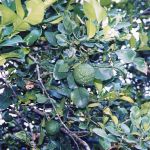| Common Name: |
Kaffir Lime |
| Other Names: |
Leech lime, makrut |
| Botanical Name: |
Citrus hystrix |
| Genus: |
Citrus |
| Family: |
Rutacea |
| Native Location: |
SE Asia |
| Cultivation: |
Well-drained, neutral to slightly acid soil in sun, with ample moisture during the growing season. Scale insects, mealybugs, and tortrix moth caterpillars may affect plants under cover. Citruses do not transplant well. |
| Propagation: |
By seed sown when ripe or in spring at 16° C (61°F); by semi-ripe cuttings in summer. Cultivars do not come true from seed. |
| Harvest: |
Flowers (C. aurantium, C. bergamia) are picked when first open and distilled for oil. Leaves (C. aurantiifolia, C. hystrix) are picked as required for flavoring and infusions. Oil is distilled from foliage, unripe fruits (C. aurantium) and ripe fruits (C. bergamia). Fruits are picked when unripe or ripe for culinary use, candying, or oil distillation, and either unripe or ripe (C. aurantium, C. reticulata) for use in Chinese medicine. |
| Height: |
3-5m (10-15ft) |
| Width: |
2.5-3m (8-10ft) |
| Hardiness: |
Min. 7°C (45°F). Sometimes withstands short periods of 0°C (32°F) |
| Parts Used: |
Leaves, fruits |
| Properties: |
A bitter, aromatic herb |
| Culinary Uses: |
Fresh or dried leaves are used to flavor soups, such as tom yam, curries, and kecap (Indonesian soy sauce), especially in SE Asian cooking. Fruit rind is candied or dried to flavor curry pastes. |
| Bibliography: |
Encyclopedia of Herbs by Deni Brown Copyright © 1995, 2001 Dorling Kindersley Limited Pp 171-172 |

